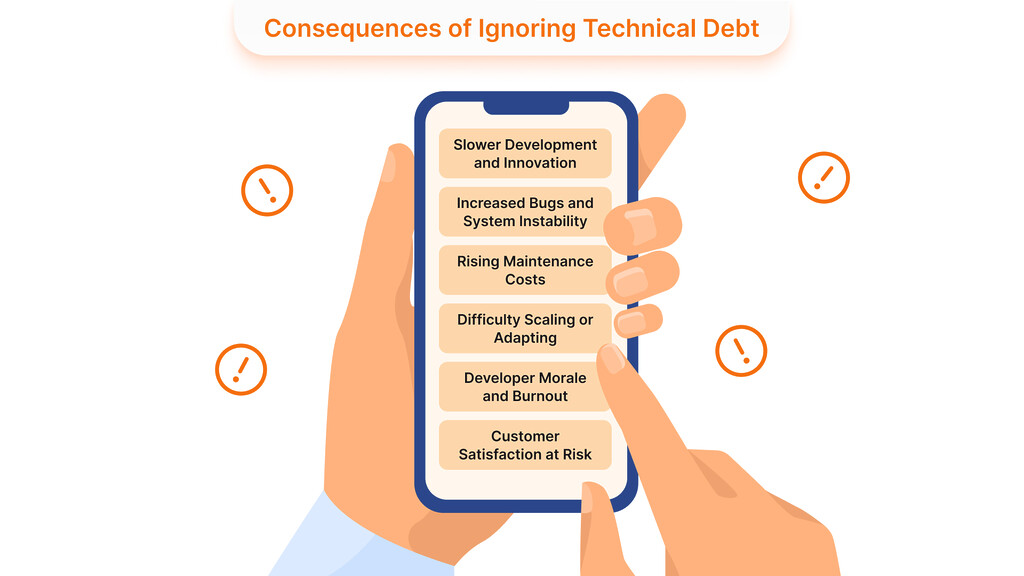Technical debt – you must have heard people use this term during a meeting, or by your development team members. It may appear jargon, but any startup founder, product manager, or business owner must comprehend it. Put in simple terms, technical debt occurs when we have to make shortcuts in a software development project to gain speed or some other short-term benefit, with the full realization that we will have to pay back the shortcuts in the future. Similar to financial debt, the shortcuts will enable you to meet short-term objectives (such as getting a feature out the door fast), but the shortcuts come with interest rates (additional work and expense in the future to repair or enhance the cranked-out code).
This newsletter will deconstruct the real meaning of technical debt, explain why it keeps piling up, and explain how it can affect your business when you have not taken care of it. More to the point, we will discuss practical measures that one can take to establish, control, and minimize technical debt as time goes on. This is so that you can make better tech and business decisions that will strike the balance between the need to move fast and ensure your products are of quality and sustainable.
Redefine Your Business with Digital Transformation
Innovative Digital Solutions, Designed for Your Unique Needs
Explore Digital TransformationWhat Is Technical Debt?
Technical debt is a metaphor created by a programmer, Ward Cunningham, to refer to the trade-off between velocity and quality in software development. Each time your team takes an easy fix rather than a less-messy, more effective solution, you are mortgaging time, and as in any debt, you pay the cost with interest in the future. And by way of illustration, think of a scenario where you push out a new feature by writing dirty code or skipping specific testing to make a deadline. It may be quicker now, but such a decision brings about additional work in the future. The jumbled code will have to be refactored one day, and the bugs not caught because adequate testing was not conducted will have to be corrected – that is the interest on your technical debt.
It is worth noting that not every technical debt is evil. Actually, the decision to incur a certain amount of technical debt may be strategic. Technical debt is common in startups, which intentionally take on technical debt as a way of faster product launch or rapid pivot. It is like a company taking out a loan to capture a business opportunity, and a development team accepting some less-than-optimal code to get the product out there sooner and with customers. The trick is doing this consciously and soundly and realizing that you must have a way to repay that debt before it gets larger. It is problematic when technical debt is not purposeful or controlled, in which such debt accrues as interest in the slow development, increased expenses, and unreliable systems. Simply put, technical debt can be regarded as a tool: if approached correctly, it can promote growth and innovation, but when neglected, it can slow your company down.
Common Causes of Technical Debt

What is technical debt? These are some of the most typical reasons, most of which will not appear strange to high-paced startup cultures:
Rushing to meet deadlines (Speed over Quality)
Time pressure is an old offender. Teams might slack off when it is close to a release date or when investors need a demo; they might write bad or even hacky code just to know that they have completed the task. These shortcuts even lead to debt that will have to be handled in the future. Speed can be very important to startups; however, when you always prioritize speed over quality, technical debt will accumulate very fast.
Leading Development Teams for Your Success
Optimize Your Project Execution with Our Dedicated Development Teams
Get Your Development TeamUnclear or Changing Requirements
In the case of vaguely defined, often changing, or ill-defined project requirements, developers may end up applying quick fixes that become off-target. The codebase turns into a patch of modifications as the team attempts to shoot a moving target. Such a lack of explicit clarity may result in suboptimal architecture and codethat must be rewritten when the real requirements are known.
Poor Code Practices and Inexperienced Development
One of the biggest contributors to technical debt is sloppy or poorly structured code. It may occur when the team is inexperienced, when there are no code standards to be followed, or when there is a lack of code review. As time goes by, dirty code becomes more difficult to maintain and debug, which slows down new development. Consider it “code rot” – the more it proliferates, the more work is needed to clean it in the future.
Lack of Documentation
Have you ever looked at a piece of code and seen no remarks or explanations? When there is no code documentation, new programmers (or even the original authors, a few months later) cannot figure out how things work. A vital context can reside in the head of one. This non-documentation is a debt in disguise – this will require more time and be more error-prone in the future to onboard and fix bugs. Not recording something may save a couple of hours now, but will cost lots of hours of interest in the future during maintenance and updates.
Inadequate Testing
Cost-cutting on testing (i.e., not writing unit tests, integration tests, or manual QA) may accelerate releases in the short term, but it will undoubtedly cause technical debt. The bugs that are not identified at an early stage will appear during production, thereby resulting in firefighting and patching later. No proper testing procedure implies that you are postponing your troubles; in other words, you are getting yourself into debt, which will become payable when those bugs will eventually have to be repaired.
Redefine Your Business with Our R&D Services
Innovation Infused into Every Product Element Through R&D-Backed Development
Learn About R&D ServicesOutdated Architecture and Scaling Challenges
Technical debt is not always a result of bad code; sometimes, technical debt is an old decision that is no longer scalable. Start-ups may start off with a fast-and-easy architecture that serves a modest number of users. However, that initial design may become a problem when the company expands quickly. Possibly, you have clung to a makeshift database or an on-premise server when you need a scalable cloud solution. This type of infrastructure and architecture debt exists when new demands are not covered due to the lack of updated technology. The system either becomes brittle, is more likely to go down, or cannot support more load because earlier decisions were not revisited in time.
Knowledge Silos in the Team
This is a reason that is not given much attention. When a single programmer knows a critical module (and nothing is written down), the entire team becomes limited. Such information silos make it dependent on certain people and they are also slower because other people cannot easily work on or change that portion of the system. It is yet another kind of debt: making the organization less agile as the knowledge is not shared, and the possibility of making mistakes or delays in case that solo expert is unavailable is higher.
All of these (sometimes many of them together) add to technical debt. Rapidly growing companies are particularly vulnerable in this regard – the temptation to rush and build features and meet milestones is too strong, and it is easy to become aware or unaware of creating a backlog of clean-up work to handle later. The positive thing is that by identifying these causes, you can begin dealing with them in advance. For example, you may choose to establish coding standards to increase the quality of the code, or create time to document and test even during a short sprint. This is all part of debt management that we will discuss later.
For an in-depth analysis of underlying causes and how to counteract them, see Effective Strategies for Managing Technical Debt in Long-Term Software Projects.
Consequences of Ignoring Technical Debt

What will occur when technical debt is not controlled? Trouble, in one word. Unpaid financial debt can kill a business like a big old truck, and so can unmanaged technical debt do to your startup. These are the significant consequences that you should be aware of:
Slower Development and Innovation
Technical debt is a burden that slows you down in development. Coders must work with messy code, go around documented bugs, or maintain old systems. This implies that any new feature or change takes an unnecessarily long time. A debt-ridden codebase is something that can eventually stall the whole engineering team. When your team spends all its time paying off the old debts rather than building new capabilities, then you have technical debt to blame.
Increased Bugs and System Instability
A dirty and hacked codebase is brittle. Minor adjustments can destroy apparently unconnected components of the system. Therefore, you will have more bugs in the software, software crashes, and firefighting. Customers will face bugs and outages (death by a thousand cuts), which will deteriorate their trust in your product. By constantly pushing back bug fixes (to work on new features), this problem is magnified multi-fold: it is similar to paying interest on top of interest, since unresolved bugs will generate new bugs.
Rising Maintenance Costs
There is a cost implication of technical debt. The older you leave that ugly piece of code or that legacy library, the costlier it gets to make a fix. Why? Since your team may be forced to spend several days disentangling spaghetti code or handling preventable outages. The amount of money required to rectify these problems increases over time because of debt. This can burst budgets and schedules of the projects. The cash that would have been used in new development is utilized to mend holes in the vessel.
Difficulty Scaling or Adapting
The startups must be able to pivot and scale in a rapidly evolving market. This is difficult when there is high technical debt. You may discover that your product is not easily extendible to adding a new feature since the code behind it cannot support it, or that once you add more users to it, the system will experience unexpected performance issues due to previous trade-offs. In a nutshell, the technical debt may undermine your capacity to change the software is hard to change because it is constructed on a wobbly leg. A mere tweak would be a major rewrite regarding severe debt.
Developer Morale and Burnout
Think of showing up to work and knowing that you can do any minor update, and it will turn into a scavenger hunt through bad code and outdated docs. It’s frustrating. When developers are trapped in a high-debt environment, they are constantly running in circles, and their efforts do not make much difference, except for being able to solve the same issues. This is demotivating and may result in burnout or turnover. No one enjoys working on a codebase full of hacks, and it is not an inspirational one. Employees would want to build some cool new features instead of fixing old problems, and without the time to clean up the code, people will lose their drive.
Customer Satisfaction at Risk
Users may be unaware of your code debt but will experience its impact. Faster updates, fewer bugs, or cool features (the team is focused on firefighting) will all compromise the customer experience. In extreme situations, technical debt can contribute to public disasters and security issues because patches were not applied, or the infrastructure was too weak to withstand long downtimes. These results may hurt your startup’s reputation and cause business losses. Concisely, technical debt is equivalent to business debt: an expense that may cost you clientele and commercial opportunities.
All these implications highlight one thing: technical debt is a business risk indeed. It may begin as a local issue in the code, but left uncontrolled, it will spill over into timelines, costs, team morale, and customer confidence. The faster you deal with it, the better, just as the faster you pay off a high-interest loan before it crushes you.
How to Identify Technical Debt in Your Product
You must first locate technical debt before you can manage it. The amount of debt lurking in many teams’ systems is more than the teams imagine. The following are some of the useful tips that can guide you to spot technical debt in your projects:
Talk to Your Developers
Your engineering team is usually in a position to know where the bodies are buried. Promote a free discussion in which developers may highlight the parts of the code that are brittle, hacky, or otherwise inflict a lot of regular suffering. When all the engineers complain about a specific module that no one wants to touch, there is a strong possibility of technical debt. Introduce a harmless channel through which devs can raise the flag on debt without being accused or finger-pointed. The thing is to plot out problems, not to accuse.
Review Your Bug Tracker and Support Tickets
A large number of bugs or customer complaints in some regions may indicate an underlying debt. For example, when one of the features results in a high volume of support requests or requires frequent hot fixes, it was likely constructed on unstable code. Find trends in maintenance work – measure your team’s unplanned work (time spent fixing bugs and problems) as a proxy of technical debt hotspots. A steady level of unplanned work indicates that the code is not good.
Conduct Regular Code Reviews and Audits
Schedule regular code review meetings where maintainability is discussed. Senior engineers or an external auditor can check the codebase to look out for what is known as code smells, duplicate code, overly complex functions, or deprecated dependencies. These are warning signs of debt. The latest static analysis tools (such as SonarQube or CodeScene) can scan your repository automatically and show you areas of your code you should focus on due to either their complexity, the number of bugs, or the absence of tests. A possible example is the cyclomatic complexity or code duplication rates, which can be used to measure the extent to which your code is in a mess, and a high score is an indication that it is time to refactor.
Check Documentation and Bus Factor
Conduct a documentation health check. Are valuable systems or APIs undocumented or known to a single individual? And, when yes, you owe documentation debt. The easiest method of testing this is by selecting a system component and asking a team member (who was not initially a contributor) to attempt to change it by using only the documentation and comments. When they find it hard, it is a sure indication of the technical debt in comprehension. Also, pay attention to the bus factor, i.e., how many people have to win the lottery (or be hit by a bus) until critical knowledge is lost? The bus factor number below 5 is a sign of knowledge silo debt.
Assess Your Architecture Fitness
Make sure that you take the time to re-evaluate your high-level architecture in terms of present and future needs. Perhaps, initially, a one-server deployment or a simple code base was sufficient, but does it still serve the purpose now? The symptoms of architectural debt are, e.g., problems with scaling (e.g., the application breaks under load or is not trivial to distribute), inability to transition to newer technology, or a myriad of workarounds in the code to support new features. When it is too painful to scale up or integrate new tools, then you are probably experiencing tech debt in your infrastructure or design. For example, an organization whose growth was fast but has been using a legacy server may realize that it cannot scale dynamically because of infrastructure debt.
With the above methods, you can build a technical debt inventory, a list of known debt items within your product. Certain groups use a formal tech debt register or backlog tickets marked technical debt. The concept is to render the unseen, visible. When you have found debt, discussing it and making informed decisions during planning meetings to use it properly and at the right time is possible. It is essential to remember that you cannot correct what you do not see, and shedding some light on these concerns is the initial step in fixing them.
Even fast-paced startups benefit from conducting routine technical audits, which should keep the company aware of debt hotspots. This article, How Regression Testing Ensures Software Quality and Stability, describes how regression testing can be a potent indicator of technical debt.
Strategies to Manage and Reduce Technical Debt

Becoming aware of technical debt is half of the battle. The second half is acting to control and slowly cut it down. You would strategically treat financial debt (you would pay it off over time or pay it off at once), and so should you with technical debt. These are some of the best practices and steps to manage tech debt in the long run:
Document and Prioritize Your Debt
The first step is to list all the relevant technical debt items your team has identified. It may contain untidy code packages, obsolete packages, the absence of tests in some sectors, bottlenecks in scaling, etc. Against each item, record the effect on the business and development (e.g., the login module is the cause of 20% of support tickets, or the outdated payment system library is a security risk). This will allow you to rank your debts according to the most critical ones. Not every debt is created equal; some could be mostly cosmetic, while others could be hazardous. Aim at the areas of high impact. Indeed, analysts recommend that IT executives capture their highest priority technical debt and know the business implications of such to plan remediation.
Make Tech Debt Visible in Roadmaps and Sprints
Do not keep technical debt as a dirty secret or assume it is gone by being placed in a backlog. Instead, incorporate debt remediation into your project road maps and iteration plans. For example, you could have a “refactoring sprint” or dedicate 10-20% of the capacity on each sprint to work on the debt items. The trick is to treat the technical debt work as regular feature work, rather than an afterthought. When you consider it part of your planning, you guarantee it is given the attention it requires. This also sends a message to the stakeholders that paying down debt is a healthy product-building process. (Pro tip: do not have a different, secret backlog of debt; instead, combine it with your primary backlog such that it competes with other items in the open.)
Chip Away with Regular Refactoring
As it is also possible to repay an outstanding financial debt by making regular payments, large technical debts can be discharged through regular refactoring and enhancements. Get your developers to tidy the code as they go along – the Boy Scout rule of leaving the code in a better state than you found it. You could reserve the initial day of every sprint to code cleaning, or establish more specific criteria, such as “achieve a higher degree of unit test coverage in module X during this month.” The little refactorings (variable renaming, long functions splitting, error handling, writing tests that do not exist) accumulate over time. With bigger architectural debt (e.g., transferring to a new database or service architecture), divide the work into phases and do them one at a time. What is the concept behind this? One should steadily pay off the debt in small, manageable amounts instead of wishing to have a significant, magic rewrite in the future. In this type of internal improvement, many agile teams put in a sustainable pace that ensures the codebase is not broken down even further.
Establish Standards to Prevent Recurring Debt
It is significant to reduce the current debt, yet it is also essential to avoid new debts. Instigate coding standards and practices that are adhered to by all – e.g., agreed code style conventions, all merges require code reviews, and a requirement that no feature is considered done without sufficient tests and documentation. In such a manner, each novel piece of code passes a quality threshold and does not contribute to the list of problems. Some of these standards can be enforced by automated tools (code style lints, continuous integration pipelines with tests and complexity alerts). You can achieve this by cultivating the culture of quality, as a result, the adoption of technical debt will not be an accidental by-product of hurry but a deliberate choice. If you take a shortcut to a deadline, document it somewhere in the code or the tracker (e.g. // TODO: tech debt – fix this later comment or a Jira ticket) so that it is on record to address in the future.
Invest in Professional UX/UI Design to Create Impactful Interfaces
Designing Seamless User Journeys That Boost Interaction and Conversion Rates
Discover UI/UX DesignIn cases where indecision delays action and inflates debt, consider adopting iterative thinking techniques like those in Overcoming Analysis Paralysis in Software Development.
Refactor with ROI in Mind
The return on investment should be considered when deciding how to address a specific debt item. Ask what we can do that we can not do well now with the improvement of this area. Perhaps a debt-reduction in the onboarding flow will reduce customer support calls by half, or rewriting a module will enable the app to see 10x as much traffic. Use such insights to construct a business case around the refactoring effort. This is handy when addressing the non-technical stakeholders on why personnel waste time on backstage undertakings. The truth is that leadership can be sold on technical debt as a business risk and a cost of opportunity. For example, tell them that failing to fix the debt within the checkout system risks losing future income since it hampers the process of introducing new payment capabilities. Management is more likely to support technical debt reduction when they view it as a means to eliminate the barriers to growth (and not as a clean-up exercise).
Monitor Progress and Adjust
Technical debt is not something that can be done once. Monitor your progress, are you making progress in the number of bugs? Is the pace of development getting any faster? You may measure such things as the count of open debt items, average time to fix a bug, or even a technical debt ratio, should you have the tools that provide one. It is also important to celebrate victories: once a piece of nasty legacy code has been refactored, celebrate the team’s effort. In the long run, you should expect fewer emergencies and more productivity by the developers as the debt is repaid. And recheck your list of debts every now and then, new debts may have accumulated, or priorities may have changed with business objectives. The point is not to eliminate technical debt (which is impossible in any software that is ever changing), but to ensure that the debt is under control and does not slow your process down. As you observe, you will provide that technical debt will be kept controlled and mostly planned (intentionally accepted when it is reasonable) and not an insidious issue.
Doing so, you will find yourself in a positive feedback loop: the smaller the debt is, the faster the development and innovation will go, and the better the business will do, and the more time you will have to spend on the product. It is like tidying your home to add that extension without the whole house falling due to faulty piping and squeaky steps. High-performance tech organizations are characterized by good technical debt management. No wonder the practices to handle debt (including refactoring and iteration planning) are explicitly mentioned in agile methods to keep the momentum and be nimble.
Tailored Mobile Solutions for Your Unique Needs
Redefine Your Business with Mobile Application Development
Explore Mobile App DevelopmentFor practical implementation tips, consult Effective Strategies for Managing Technical Debt in Long-Term Software Projects.
Build Wisely, Scale Confidently
Technical debt may appear to be a dry technical issue, but as we have discussed in this article, it has massive consequences for your startup’s pace, budget, and competitiveness. The lesson learned is that technical debt is not something to be afraid of, but to control. A certain amount of tech debt is inevitable in every startup: sometimes you must go fast; a good measure of tech debt is in your best interest. They are aware that today’s quick hack may turn into tomorrow’s roadblock, unless taken care of.
Being a founder, product manager, or business leader, you do not need to read all the lines of code, but you should create a fast-paced and long-term-oriented culture. Make your team members feel free to report technical debt problems and take time to resolve them. Apply the strategies as mentioned above, i.e., having a debt backlog and refactoring regularly, applying best practices so that the debt is avoided, and never stop investing in the health of your codebase. It is like paying a credit card: even a small effort will help you avoid a lot of trouble in the future.
Finally, technical debt management is all about sustainability. With clean, stable, and scalable technology, your business can seize the opportunity faster and provide better products to your customers. And they consider technical debt a first-class concern. Demystifying it and facing it head-on will enable your startup to operate quickly and construct durable things.
Make Hypersense Software your technology partner in innovative, scalable solutions. Read about our servicesand get in touch.
Key Takeaways
- The price paid for the developmental speed versus sustainability is called technical debt.
- It is typical of startups because of tight deadlines, changing needs, and small teams.
- When technical debt is ignored, it may lead to a slower release, an increase in cost, and burnout.
- Monitor the technical debt using code metrics, tooling, and team feedback.
- Controlling debt with transparency, gradual refactoring, automation of tests, and process harmonization.
- The problem is that technical debt is not a bad thing in itself; it is a risk that can be used to grow.










